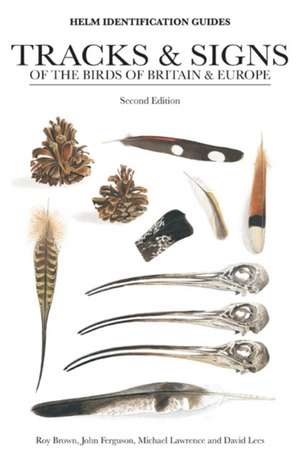Tracks and Signs of the Birds of Britain and Europe: Helm Identification Guides
Autor David Lees, John Ferguson, Michael Lawrence, Roy Brownen Limba Engleză Paperback – 29 apr 2003
Din seria Helm Identification Guides
-
 Preț: 210.24 lei
Preț: 210.24 lei - 25%
 Preț: 433.05 lei
Preț: 433.05 lei -
 Preț: 254.58 lei
Preț: 254.58 lei - 25%
 Preț: 431.73 lei
Preț: 431.73 lei - 22%
 Preț: 379.70 lei
Preț: 379.70 lei - 25%
 Preț: 362.07 lei
Preț: 362.07 lei - 25%
 Preț: 429.06 lei
Preț: 429.06 lei - 27%
 Preț: 511.42 lei
Preț: 511.42 lei - 24%
 Preț: 504.12 lei
Preț: 504.12 lei - 17%
 Preț: 366.29 lei
Preț: 366.29 lei - 25%
 Preț: 429.89 lei
Preț: 429.89 lei - 43%
 Preț: 516.22 lei
Preț: 516.22 lei - 26%
 Preț: 421.80 lei
Preț: 421.80 lei - 16%
 Preț: 369.12 lei
Preț: 369.12 lei - 31%
 Preț: 361.69 lei
Preț: 361.69 lei - 26%
 Preț: 420.17 lei
Preț: 420.17 lei - 17%
 Preț: 365.34 lei
Preț: 365.34 lei - 35%
 Preț: 589.88 lei
Preț: 589.88 lei - 11%
 Preț: 478.64 lei
Preț: 478.64 lei - 49%
 Preț: 424.48 lei
Preț: 424.48 lei - 27%
 Preț: 379.03 lei
Preț: 379.03 lei - 17%
 Preț: 362.76 lei
Preț: 362.76 lei - 44%
 Preț: 344.13 lei
Preț: 344.13 lei - 11%
 Preț: 406.47 lei
Preț: 406.47 lei
Preț: 242.89 lei
Nou
46.49€ • 50.52$ • 39.08£
Carte indisponibilă temporar
Specificații
ISBN-10: 0713653825
Pagini: 336
Ilustrații: 66 colour pl diagrams, line drawings
Dimensiuni: 152 x 234 x 21 mm
Greutate: 0.7 kg
Editura: Bloomsbury Publishing
Colecția Helm
Seria Helm Identification Guides
Locul publicării:London, United Kingdom
Recenzii
Descriere
Featuring updated data for this second edition, this is a field guide to the tracks and signs of European birds. It covers tracks, trails, nests, roosts, feeding and behavioural signs, pellets, droppings, and feathers and skulls, with illustrations showing the signs as they appear in the field.
Caracteristici
Notă biografică
The author team of Tracks and Signs of the Birds of Britain and Europe is Roy Brown, Michael Lawrence, John Ferguson and the late David Lees. Experienced field ornithologists specialising in track identification and fieldwork skills, they worked together on the first two editions of this book in the 1990s and early 2000s, with Roy, Michael and John reprising this role for the third edition.Professor Roy Brown studied Earth Sciences at University, graduating from Leeds University in 1968, before completing an MSc in Conservation and a PhD in Soil Zoology. He then went on to hold a number of academic and research posts, prior to serving as the Deputy National Park Officer at the North York Moors National Park between 1974 and 1989. Since then, he has held multiple University Chairs in Biological Sciences and Rural Resource Management, as well as publishing many books and papers on Natural History and Resource Conservation. He is currently a Visiting Professor in Epidemiology and Invasive Species Control.Michael Lawrence has been interested in natural history from an early age and worked at the Zoology Department of University College London, where he became friends with co-author John Ferguson. Michael has travelled to study and record material that has helped inform multiple books, including The Country Life Guide to the Animals of Britain and Europe and the First and Second Edition of this book. Michael retains his special interest in foreign travel to study evidence of rare and unusual species.John Ferguson began his career as a junior laboratory technician in the Zoology Department of University College London, where museum preparation and attending lectures as a projectionist was a good grounding in animal biology, anatomy and taxonomy. He then moved on to Imperial College London, where he worked as Chief Technician, before spending time in Kuwait, and also working as a Technical Service Representative back in the UK. He is the co-author of the First and Second Edition of this book.David Lees began training as a gardener at Hampton Court before deciding to join the Royal Marines. When he returned home, he had time to explore his fascination for wildlife and started surveying for the BTO nest recording programme. Through this work, he became part of a team studying Kestrel and Owl breeding, and carried out ringing of many species throughout the UK. A keen ornithologist, David spent time abroad, gathering evidence for the First and Second edition of this book, and providing much of the biometrical data. David sadly passed away in 2010.
Cuprins
AcknowledgementsIntroductionChapter 1: HabitatChapter 2: Tracks and TrailsChapter 3: Nests and RoostsChapter 4: Feeding Signs, Pellets and DroppingsChapter 5: SkullsChapter 6: FeathersEuropean Bird Protection and Study OrganisationsBibliographyIndex
